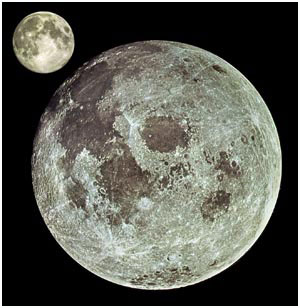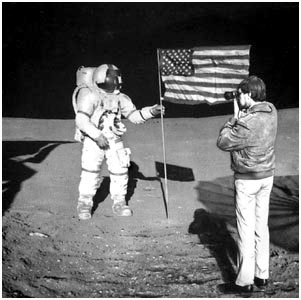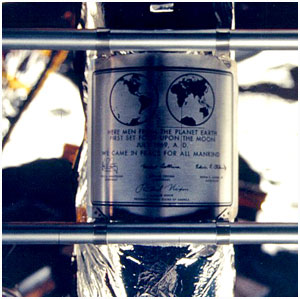|
2. The shadows on the Moon, cast by only one light-source - the Sun - and in the absence of an atmosphere, would be inky black. So how is it that in several photographs, including the famous one taken by Neil Armstrong of Edwin 'Buzz' Aldrin, details in the shadowed side of the spacesuit are clearly visible? Obviously there must have been a second studio light. The spacesuits were made of very reflective material, in order to reduce solar heating. Therefore they reflected light from anything around them, including another astronaut, equipment - and the landscape, which, although made of dark material, still reflects sunlight quite brightly from its upper surface layer. Don't forget, either, that reflections in the curved, gold-coated visors of the astronauts' helmets would show every detail of the cameramen, lighting etc. on the set - were there any. 3. What about the American flag that was placed on the lunar surface? One side of that should surely be dark because in shadow, yet it always looks bright. Take a look at any flag outside. The material from which it is made allows some light to pass through, making the other side glow. When in the shadow of another object, the same applies as for the spacesuit - reflected light. 4. But when the astronauts were placing the flag in position it appeared to flutter, as if in a breeze. Oops! I bet NASA never thought of that! Kaysing makes a lot of this one: "They had air conditioners going to keep the astronauts cooler, since they were wearing little spacesuits. What we saw was wind." Would you care to run that by me again please? They were inside spacesuits, yet air conditioners were running outside, making the flag wave? The truth is that the flag was supported from its aluminium pole by a wire frame, since obviously with no air it would otherwise simply flop down limply. This was quite springy, and Neil and Buzz in particular found it hard to drive the pole into the lunar soil or 'regolith' and had to twist it. Their efforts made the flag wave. You will observe that it never does so as an astronaut or rover passes it, as it would if a draft was created. . . 5. The shadows cast by the LM, astronauts, and equipment are not parallel, as they should be with only one bright light-source. This proves that extra lamps were used. (Oops. . . ) Rene points out that shadows sometimes converge, sometimes diverge on the lunar surface. Has he ever actually looked at shadows on an earthly landscape? True, on a completely flat surface shadows are parallel. But even then it depends upon your viewpoint: railways lines are parallel, yet they appear to converge in the distance. Likewise with shadows when the Sun is behind you. Apart from that, any variation in the surface - mounds, hillocks, craters - will alter the appearance of shadows, making them alter direction or change shape. You will notice also that there are never double shadows, such as one often sees in movies, caused by two or more lights. 6. Well, what about the fact that no stars appear in any of the photos? There is no atmosphere on the Moon, so stars should be clearly visible in the black sky. (Oops. . . ) Any photographer can answer this one. Neither the human eye nor photographic film (especially in 1969) is able to respond to both the bright landscape and objects lit by the Sun, and at the same time to faint objects like stars. Have you ever tried to see stars while standing under a street light? But Kaysing adds: "Astronomers could have easily discerned that the star positions were not those that would have appeared in a photo taken from the Moon. They could not fake it, so they simply ignored it." What does he mean by this? If he is suggesting that the constellations will appear differently from how they do from Earth, he could not be more wrong: the Moon is in our back yard, and one would have to travel many light-years, not a quarter of a million miles, to see any noticeable difference. And any astronomer could work out which stars would be visible from anywhere on the lunar surface. But Kaysing continues: "If you were to talk to Aldrin or Armstrong or any of the other astronauts, they would actually not respond in any way to questions regarding stars." Oh, really? At a press conference, Patrick Moore asked this very question, and Neil Armstrong replied that they were unable to see stars from the daylight side of the Moon, except with instruments. |
 The Moon from Apollo 11: The inset is how we see the Moon from Earth. Look at the dark "Maria" areas... it would be impossible to take this photo from the Earth... you'd have to be half way there and a long way round!  Reunion: Surveyor 3 the unmanned Lunar probe which landed on the Moon in 1967 and "Intrepid" the Apollo 12 Lunar Module... clearly visible on the horizon.  "Smile please... I'm from the Sun"! David Hardy's trick photo... that's him taking the shot. 
"HERE MEN FROM THE PLANET EARTH |
7. The LM should have blown away dust and formed a crater as it landed. And, when we see the ascent stage of Apollo 15, 16 and 17 blast off from the Moon, why is no rocket exhaust visible?
As with the later landers, the thrust of Eagle was reduced to 25% as it came in to touch down, and it was also moving forward very gently. Radial streaks caused by the motors can in fact be seen in some photos. Every painting of the lunar lift-off made before the event (including my own!) does show flames beneath the vehicle as it separates from the descent stage. So one might have expected NASA to do the same if it faked the film. But in reality the gases from the single motor expand so rapidly in vacuum, with no air to compress them, that they are in effect invisible. (Artists usually show stars, too ? an advantage over the camera!)
8. Radiation would have destroyed the film, and would also have damaged or even killed the astronauts. And what about meteorites, which would have blasted the astronauts and vehicles?
It has been known since 1958 that Earth is surrounded by doughnut-shaped radiation belts at heights from 7,500 to 20,000 kilometres. But even James Van Allen, who discovered them, says that you would have to spend a month inside the belts for them to do any harm. Apollo passed through the thinnest part of them in hours. Had a solar flare occurred, they would have used the bulk of Apollo as a shield. As for film, there has never been a problem, even with photos taken from the Shuttle in Earth-orbit. But while we are speaking of this, many photographs were taken of the Earth and Moon during the voyage, including several taken when halfway to the Moon, showing it with the dark, circular Mare Crisium near its centre, instead of at about 2 o'clock as we are used to seeing it from Earth. Others show the side turned away from Earth in great detail. It would be quite impossible to fake these convincingly. It has also been claimed that the astronauts could not have taken photos with their Hasselblad 70mm camera, because gloves made their fingers too clumsy. But the cameras were specially designed with large shutter-releases, and had no viewfinder; it was just point-and-shoot. It is true that micrometeoroids pass continuously through space. Yet even during showers, such as the Leonids, not one of the 700 satellites now in orbit have been damaged!
9. One of the rocks in a photo taken of Charles Duke by John Young during the Apollo 16 mission has a 'C' marked on it. This must be a polystyrene 'prop', placed there by set-dressers as a marker for Charles' position. And there are several photos in which the automatic crosshairs are covered by objects such as rocks or equipment, instead of always being superimposed over them.
This 'C' is only visible on one print; it does not appear on the master copy. Clearly it is nothing but a tiny hair or speck of dust which found its way there during printing. As for those crosshairs, this always occurs when the area is very light or very dark. The crosshairs are etched onto the lens of the camera, and clearly over- or under-exposure occasionally causes the cross to vanish.
10. The lunar rock brought back came from Earth, or was made in secret NASA laboratories.
The 382 kilograms of rock samples brought back could not fool scientists for a moment were they not genuine. Cosmic radiation actually helps defeat the conspiracy theorists here, as Earth's atmosphere shields us from most of the radiation, but lunar rocks have been bombarded for 3.9 billion years. The oldest Earth rocks are 165 million years old. And lunar rock contains virtually no oxygen or water. Finally, laser reflectors, called the Lunar Laser Ranger Experiment, were left at Apollo sites. Most are still working, and the MacDonald Observatory in Texas fires a laser beam at four of them 240 times each year, and gathers information. The conspiracy theorists conveniently ignore this fact! However, within a few years probes carrying cameras with greater resolution than anything previously available will orbit the Moon, and hopefully will be able to send back images of the Apollo landing sites, complete with landers and rovers, thus silencing these cranks once and for all. .
© David A. Hardy, 2004. http://www.astroart.org


